Acanthus family
| Acanthus family | ||||||||||||
|---|---|---|---|---|---|---|---|---|---|---|---|---|

Barleria prionitis , inflorescence with zygomorphic flowerstypical of Acanthaceaewith overgrown petals |
||||||||||||
| Systematics | ||||||||||||
|
||||||||||||
| Scientific name | ||||||||||||
| Acanthaceae | ||||||||||||
| Yuss. |
The acanthus family (Acanthaceae), also known as the bear's claw family , are a family of plants within the order of the mint family (Lamiales). It is a predominantly tropical family. With around 4000 species, it is one of the twelve most species-rich families of flowering plants (Magnoliopsida, angiosperms).
description

Appearance and leaves
They usually grow as perennial , rarely annual herbaceous plants ; there are also some woody taxa , it is half-shrubs , shrubs or rarely small trees . Most species thrive terrestrially, but there are also some epiphytes . They grow independently upright, prostrate or climbing, if there are twisting plants then this is done in a clockwise direction. The secondary growth in thickness is based on a conventional cambium ring. Air roots are present at Avicennia . The stem or stem branches are round or angular in cross section, often with swollen node ( Nodien ). Sometimes there are thorns that have developed from reduced leaves, bracts or bracts.
The leaves are arranged in basal rosettes or opposite, rarely alternate or whorled, distributed along the stem axis , whereby the leaves of an opposing pair can both be the same (isophyll) or different (anisophyll). The leaf blades are usually simply to rarely divided. The leaf nerve is pinnate and reticulate. The leaf surfaces can be dotted with glands. The leaf margins are smooth, wavy, notched, serrated or serrated. Stipules are absent.



Inflorescences, flowers and flower ecology
The flowers are rare individually, usually several in dense clusters or many in terminal or lateral, ährigen , rispigen , traubigen , diachsial zymösen inflorescences together. Per flower or diachsialen bundles is a little depending on the type and green or bright-colored large and liner sheet available. Usually there are two bracts under each flower , rarely missing. The flowers are stalked or sessile.
The hermaphrodite flowers are usually five-fold and more or less strongly zygomorphic . The rarely four, mostly five sepals are fused at least at their base and end in four, five, ten or twenty calyx teeth; in Thunbergia the calyx is reduced to a full-rim, cup-shaped ring. The crown is resupinate in some taxa by a 180 ° of the corolla tube . The five petals are mostly fused into a cylindrical or funnel-shaped corolla tube. The corolla lobes can be almost the same or the crown is often two-lipped, or rarely is it single-lipped with three corolla lobes. The upper lip can be almost entire to two-lobed. The lower lip is three-lobed. The corolla lobes can be ascending, spoon-like, twisted or open in the flower bud. The original five are always reduced to four or two fertile stamens ; they are shorter or longer than the corolla tube. The stamens are free or grown together in pairs, only with Strobilanthes are they all grown together at their base. The dust bags have one or two counters and usually open with a longitudinal slot. There are (zero to) two or three staminodes present. Two carpels are a zweifächerigen, Upper permanent ovary grown. In the central-angled placentation, there are two to many ovules per ovary compartment . There is a ring-shaped and nectar-producing disc at the base of the ovary. The thin stylus ends in a funnel-shaped scar or two scar branches, one or both of which can be curved or rolled back, sometimes one suppressed.
The flower formula is:
Fruits and seeds
The sometimes stalked, loculicidal capsule fruits are bilobed and explosively hurl the two, usually only a few or rarely many seeds out. The septum remains attached to or separates from the inner wall of the ripe fruit capsule. There may be a beak at the top of the fruit. The fruits are rarely stone fruit-like. The surface of the seeds is smooth, roughened, glabrous, or hairy, sometimes with hygroscopic trichomes that expand when wet.
Sets of chromosomes
The basic chromosome numbers are x = 7 to 21.
ingredients
Cystolites are often present (but not, for example, in Acanthus , Blepharis , Nelsonia , Ophiorrhiziphyllon , Staurogyne , Thunbergia ), they are formed by the accumulation of silica and calcium carbonate . The seeds contain fatty oils , proteins and reserve cellulose , but probably no starch. Important ingredients are polyphenols , essential oils , heterosides , non-volatile isoprenoid compounds and alkaloids .
ecology
The species of the Acanthaceae family play an important ecological role because the structure of their flowers is adapted to many different pollinators. The pollination is carried by birds, for example, humming and sunbirds , ( ornithophily ) or by insects such as bees, as well as day moth ( Entomophilie ) or bats ( Chiropterophilie ). The survival of these animals depends on the supply of nectar and pollen.
Systematics and distribution



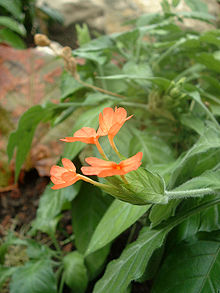




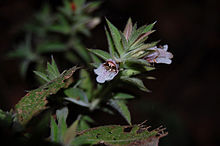








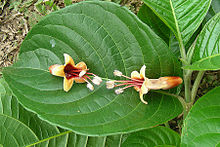

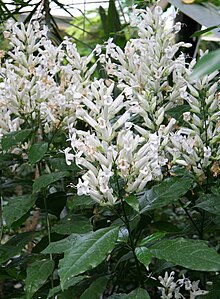

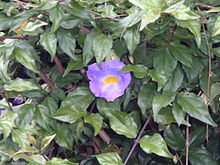
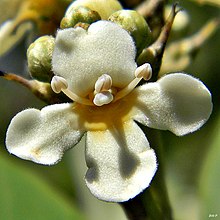
The Acanthaceae family was first published in 1789 by Antoine Laurent de Jussieu under the name "Acanthi" . Type genus is Acanthus L. Synonyms for Acanthaceae Juss. are: Avicenniaceae Miq. , Justiciaceae Raf. , Mendonciaceae Bremek. , Meyeniaceae Sreem. , Nelsoniaceae Sreem. , Thunbergiaceae Lilja .
Species occur in the Holarctic , Paleotropic , Neotropic , Capensis and Australian flora area. They thrive from temperate to tropical areas, with most of the species being native to the tropics . Centers of biodiversity are the Indomalayan Unterreich, Africa , Brazil and Central America .
The family Acanthaceae belongs to the order Lamiales .
The Acanthus family (Acanthaceae) is divided into four subfamilies with at least six tribe and 229 to 250 genera with 3500 to 4000 species:
- Subfamily Acanthoideae Link : They are mostly herbaceous plants. There are mostly conspicuous bracts present. The distribution is worldwide - there are about ten genera in the New World and about ten genera in the Old World . In this subfamily, the capsule fruits are stalked. The subfamily of the Acanthoideae is divided into six tribes and contains about 217 to 237 genera with about 3220 species:
- Tribus Acantheae: The four stamens each have only one theca . It contains about 20 to 21 genera and about 500 species:
- In the Old World: They have two-lipped corollas. There are about ten genera:
- Acanthopsis Harvey : The approximately 64 species occur in the Capensis .
- Acanthus L. (Syn .: Acanthodus Raf. ): It contains 20 to 25 species that occur in tropical to subtropical areas of the Old World: southern Europe , Africa , southern Asia , the Malay Archipelago and Australasia .
- Achyrocalyx R.Benoist : The only three species occur only in Madagascar .
- Blepharis Juss. : The approximately 130 species are distributed from Africa across the Arabian Peninsula to southern Asia and Southeast Asia.
- Crossandra Salisbury : The 50 to 52 species are distributed in Africa, Madagascar, on the Arabian Peninsula and on the Indian subcontinent .
- Crossandrella C.B. Clarke : The only two species are common in tropical Africa.
-
Cynarospermum Vollesen : It contains only one species:
- Cynarospermum asperrimum (Nees) Vollesen : It is native to India .
- Sclerochiton Harvey : The 18 species are distributed from tropical to southern Africa .
- Stenandriopsis S.Moore : The species were previously in the genus Stenandrium Nees . The 17 species are common in Africa and Madagascar.
-
Streptosiphon Mildbr. : It contains only one type:
- Streptosiphon hirsutus Mildbr. : It only occurs in Tanzania .
- In the New World: They have single-lipped corollas. There are about ten genera:
- Aphelandra R.Br. : The approximately 180 species are distributed from Mexico to Peru , Bolivia and Argentina .
-
Cyphacanthus Leonard : It contains only one species:
- Cyphacanthus atopus Leonard : It only occurs in Colombia .
- Encephalosphaera Lindau : The three types are distributed in Brazil , Colombia, Ecuador and Peru.
- Geissomeria Lindl. : The 15 or so species are common in the Neotropics , mainly in Brazil.
- Holographis Nees : The 16 or so species are common in Mexico.
- Neriacanthus Benth. : The total of five species are distributed in Panama , Colombia, Venezuela , Ecuador, Peru and one species ( Neriacanthus purdieanus ) occurs in Jamaica .
-
Orophochilus Lindau : It contains only one species:
- Orophochilus stipulaceus Lindau : It occurs only in Peru.
- Rhombochlamys Lindau : The only two types occur only in Colombia.
-
Salpixantha Hook. : It contains only one type:
- Salpixantha coccinea Hook. : It only occurs in Jamaica.
- Stenandrium Nees : The 40 to 50 species are distributed in Florida and Texas , Argentina and the Caribbean islands .
- In the Old World: They have two-lipped corollas. There are about ten genera:
- Tribe Andrographidae:
- It contains about seven genera with about 75 species:
-
Andrographis Wall. ex Nees (Syn .: Haplanthoides H.W.Li , Haplanthus Nees ): The approximately 20 species are distributed in tropical to subtropical Asia, including:
- Kalmegh ( Andrographis paniculata (Burm.f.) Wall.ex Nees )
- Cystacanthus T. Anderson
- Diotacanthus Benth.
-
Graphandra J.B.Imlay : It contains only one species:
- Graphandra procumbens J.B.Imlay : It occurs only in Thailand .
- Gymnostachyum Nees : The 30 or so species are common in tropical Asia.
- Haplanthodes Kuntze : The four or so species occur in India .
- Phlogacanthus Nees : The 15 or so species are common in Indomalesia .
-
Andrographis Wall. ex Nees (Syn .: Haplanthoides H.W.Li , Haplanthus Nees ): The approximately 20 species are distributed in tropical to subtropical Asia, including:
- It contains about seven genera with about 75 species:
- Tribus Barlerieae:
- It contains about twelve genera with about 420 species:
-
Acanthura Lindau : It contains only one species:
- Acanthura mattogrossensis Lindau : It occurs in Brazil.
- Barleria L .: The 80 to 120 to 300 species are common in tropical areas of Africa and Asia, a species in the Neotropic .
- Barleriola Oerst. : The six or so species occur on Caribbean islands .
- Borneacanthus Bremek. : The six or so species occur only on Borneo .
-
Boutonia DC. : It contains only one type:
- Boutonia cuspidata DC. : It occurs in Madagascar.
- Chroesthes Benoist : The only three types are common in China, Vietnam , Laos , Myanmar , Thailand and Malaysia .
- Crabbea Harv. (Syn .: Acanthostelma Bidgood & Brummitt , Golaea Chiov. ): The 16 or so species are common in Africa.
- Hulemacanthus S.Moore : The only one to three species occur only in New Guinea .
- Lasiocladus Bojer ex Nees : The five or so species occur in Madagascar.
- Lepidagathis Willd. : It contains about 100 species in tropical to subtropical areas worldwide, mainly in the Paleotropic .
-
Pericalypta Benoist : it contains only one species:
- Pericalypta biflora Benoist : It occurs in Madagascar.
-
Schaueriopsis Champl. & I.Darbysh. : It contains only one type:
- Schaueriopsis variabilis Champl. & I.Darbysh. : It thrives in the forests of the eastern Congo Basin in the eastern part of the Democratic Republic of the Congo .
-
Acanthura Lindau : It contains only one species:
- It contains about twelve genera with about 420 species:
- Tribus Justicieae: It contains about 104 genera with more than 2000 species:
- Subtribus Diclipterinae Nees: It contains about nine genera (selection):
- Dicliptera Juss. : It contains about 150 species.
- Hypoestes Sol. ex R.Br. : The 150 or so species are common in the Old World.
- Subtribus Isoglossinae: It contains ten genera:
- Brachystephanus Nees (including Oreacanthus Benth. ): The approximately 24 species are distributed in tropical Africa and Madagascar.
-
Conocalyx benoist : it contains only one species:
- Conocalyx laxus Benoist : It occurs in Madagascar.
- Forcipella Baill. : The five or so species occur only in Madagascar.
- Isoglossa Oerst. (including Strophacanthus Lindau ): The approximately 50 species are distributed in Africa, the Arabian Peninsula, Madagascar and Asia.
- Populina Baill. : The only two species occur only in Madagascar.
- Ptyssiglottis T.Anderson : The 33 or so species are distributed from Southeast Asia to "Papuasia".
- Kalbreyeriella Lindau : The only three species are common in Central America and Colombia.
- Razisea Oerst. : The five species are distributed from Mexico through Central America to Colombia.
- Sphacanthus Benoist : The only two species occur only in Madagascar.
- Stenostephanus Nees (including Cylindrosolenium Lindau , Habracanthus Nees , Hansteinia Oerst. , Kalbreyeracanthus Wassh. , Syringidium Lindau ): The approximately 82 species are distributed from Mexico to Bolivia.
- Not classified in a subtribe:
-
Afrofittonia Lindau : It contains only one species:
- Afrofittonia silvestris Lindau : It occurs in tropical West Africa .
-
Ambongia Benoist : It contains only one species:
- Ambongia perrieri Benoist : It occurs in Madagascar.
-
Angkalanthus Balf. f. : It contains only one type:
- Angkalanthus oligophylla Balf. f. : This endemic occurs only on Socotra .
- Anisacanthus Nees : The eight or so species are distributed from the USA to Mexico.
- Anisotes Nees : The 19 or so species are common in tropical Africa and Madagascar.
- Aphanosperma T.F.Daniel : It contains only one type:
- Aphanosperma sinaloensis (Leonard & Gentry) TFDaniel : It is native to northwestern Mexico.
-
Ascotheca Heine : It contains only one species:
- Ascotheca paucinervia (CBClarke) Heine : It is common in tropical West Africa.
-
Asystasia flower : The approximately 40 to 70 species are common in tropical to subtropical areas of the Old World, for example:
- Asystasia gangetica (L.) T. Anderson
- Ballochia Balf. Q : With three types occur on Socotra.
-
Calycacanthus K. Schum. : It contains only one type:
- Calycacanthus magnusianus K.Schum. : It occurs in New Guinea.
- Carlowrightia A.Gray : The approximately 25 species are distributed from the USA to Costa Rica .
-
Celerina Benoist : It contains only one species:
- Celerina seyrigii Benoist : It occurs in Madagascar.
-
Cephalacanthus Lindau : It contains only one species:
- Cephalacanthus maculatus Lindau : It occurs in Peru.
-
Chalarothyrsus Lindau : It contains only one species:
- Chalarothyrsus amplexicaulis Lindau : It occurs in Mexico.
- Chamaeranthemum Nees (Syn .: Chameranthemum Nees ): The four or so species are common in the Neotropic.
- Chileranthemum Oerst. : The only two types occur in Mexico.
- Chlamydocardia Lindau : The four or so species are common in tropical West Africa.
-
Chlamydostachya Mildbr. : It contains only one type:
- Chlamydostachya spectabilis Mildbr. : It occurs in tropical East Africa .
- Chorisochora Vollesen : Of the only three species, one species occurs in southern Africa and two species occur only on Socotra.
- Clinacanthus Nees : The only three types are common in Asia.
- Clistax Mart. : The only two types are common in Brazil.
- Codonacanthus Nees : The only two species are common in eastern and southern Asia.
- Cosmianthemum Bremek. : The ten or so species are common in Southeast Asia, particularly in Borneo .
- Cyclacanthus S.Moore : The 15 or so species are widespread on the Asian continent, of which around eight are found in China.
-
Danguya Benoist : It contains only one species:
- Danguya pulchella Benoist : It occurs in Madagascar.
-
Dasytropis Urb. : It contains only one type:
- Dasytropis fragilis Urb. : It occurson serpentine rockin eastern Cuba .
-
Dichazothece Lindau : It contains only one type:
- Dichazothece cylindracea Lindau : It occurs in eastern Brazil.
- Dicladanthera F. Muell. : The only two types are common in western Australia .
- Dicliptera Juss. (Syn .: Diapedium K.D.Koenig ): The about 100 species are common in the tropics and moderate latitudes worldwide.
- Filetia Miq. : The eightor sospecies occur on Sumatra and the Malay Peninsula .
- Fittonia ( Fittonia Coem. ): The only two species occur in Peru.
- Glossochilus Nees : The only two species are common in southern Africa.
- Graptophyllum Nees : The ten or so species are common in Australia and the southwestern Pacific.
-
Gypsacanthus E.J. Lott et al. : It contains only one type:
- Gypsacanthus nelsonii E.J. Lott et al. : It occurs in Mexico.
- Harpochilus Nees : The only three species are common in Brazil.
- Henrya Nees : The only two types are common in Central America.
- Herpetacanthus Nees : The ten or so species are distributed from Panama to Brazil.
- Hoverdenia Nees : it contains only one type:
- Hoverdenia speciosa Nees : It occurs in Mexico.
-
Ichthyostoma Hedrén & Vollesen : It contains only one species:
- Ichthyostoma thulinii Hedrén & Vollesen : It occurs in southeastern Ethiopia and Somalia .
-
Isotheca Turrill : It contains only one species:
- Isotheca alba Turrill : It only occurs in Trinidad .
- Jadunia Lindau : One or two species only occur in New Guinea .
- Juruasia Lindau : The only two types are common in Brazil.
-
Justicia L. (Syn .: Adatoda Adans. , Adhatoda Mill. , Calophanoides Ridley , Ecbolium Kuntze non Kurz , Gendarussa Nees , Mananthes Bremekamp , Rhaphidospora Nees , Rostellaria Nees non CFGaertner , Rostellularia Reichenb. ): It contains about 600 to 700 species ( including Beloperone and Jacobinia ; is not monophyletic ) in tropical and temperate areas worldwide, including 43 species in China. Including:
- Indian lungwort ( Justicia adhatoda L. )
-
Kudoacanthus Hosok. : It contains only one type:
- Kudoacanthus albonervosa Hosokawa : It only occurs in Taiwan . It is known only from a few collections and thrives in evergreen rainforests at altitudes of 600 to 700 meters.
-
Leptostachya Nees : it contains only one species:
- Leptostachya wallichii Nees : It is widespread in tropical Asia.
- Linariantha B.L.Burtt & RMSm.
- Mackaya Harv. : The only three species have a disjoint area in the Himalayan region and in South Africa.
-
Marcania J.B.Imlay : It contains only one species:
- Marcania grandiflora J.B.Imlay : It occurs in Thailand.
- Megalochlamys Lindau : The approximately three species occur in southwest Africa and in Arabia .
-
Megalostoma Leonard : it contains only one species:
- Megalostoma viridescens Leonard : It is common in Central America.
-
Megaskepasma Lindau : It contains only one type:
- Megaskepasma erythrochlamys Lindau : It is common in Central America.
-
Melittacanthus S.Moore : It contains only one species:
- Melittacanthus divaricatus S.Moore : It occurs in Madagascar.
- Metarungia Baden : The only three types are common in Africa.
-
Mexacanthus T.F.Daniel : It contains only one species:
- Mexacanthus macvaughii T.F.Daniel : It occurs in western Mexico.
- Mirandea Rzed. : The six or so species are common in Mexico.
- Monechma Hochst.
- Monothecium Hochst. : The only three species are distributed from tropical Africa to southern India.
- Odontonema Nees : The approximately 26 species are common in the Neotropic.
- Oplonia Raf. : The 19 or so species are common in the Neotropics and Madagascar.
- Pachystachys Nees : The eleven or so species are common in the Neotropic.
-
Pelecostemon Leonard : It contains only one species:
- Pelecostemon trianae Leonard : It occurs in Colombia.
- Peristrophe Nees : The approximately 40 species are distributed in tropical to subtropical Asia, Africa and Madagascar.
- Phialacanthus Benth. : The approximately five species are distributed from the Himalayas to the Malay Peninsula.
-
Phidiasia Urb. : It contains only one type:
- Phidiasia lindavii Urb. : It occurs in Cuba.
- Podorungia Baill. : The five or so species occur only in Madagascar.
- Poikilacanthus Lindau : The six or so species are common in the Neotropic.
-
Pranceacanthus Wassh. : It contains only one type:
- Pranceacanthus coccineus Wassh. : It occurs in the Amazon region of Brazil.
- Pseuderanthemum Radlk. : It contains about 50 species with pantropical distribution.
- Pseudodicliptera Benoist : The only two species occur only in Madagascar.
-
Psilanthele Lindau : It contains only one species:
- Psilanthele eggersii Lindau : It occurs in Ecuador.
- Pulchranthus V.M.Baum et al. : The four types are common in South America.
- Rhinacanthus Nees : The approximately 25 species are distributed in tropical to subtropical areas of Africa and Asia.
- Ritonia Benoist : The only three species occur only in Madagascar.
- Rungia Nees : The approximately 50 species are common in the tropics and subtropics of the Old World.
- Ruspolia Lindau : The four or so species are common in tropical Africa.
- Ruttya Harv. : The three or so species occur in Africa, Madagascar and Yemen .
- Salpinctium T.J. Edwards : The up to three species are common in southern Africa, the (sometimes also put to Asystasia ).
-
Samuelssonia Urb. & Ekman : It contains only one type:
- Samuelssonia verrucosa Urb. & Ekman : It only occurs in Hispaniola .
- Sapphoa Urb. : The only two species occur only in Cuba.
- Schaueria Nees : The eight or so species are common in Brazil.
-
Sebastiano-schaueria Nees : It contains only one species:
- Sebastiano-schaueria oblongata Nees : It occurs in Brazil.
- Spathacanthus Baill. : The three or so species are common in Central America.
-
Sphinctacanthus Benth. : It contains only one type:
- Sphinctacanthus griffithii (T.Anderson) Benth. : It is common from northeast India to Myanmar.
- Streblacanthus Kuntze : The seven or so species are common in Central America.
-
Tessmanniacanthus Mildbr. : It contains only one type:
- Tessmanniacanthus chlamydocardioides Mildbr. : It occurs only in eastern Peru.
- Tetramerium Nees : The approximately 28 species are common in Central America.
- Thysanostigma J.B.Imlay : There are around two species in southern Thailand and on the Malay Peninsula.
-
Trichaulax Vollesen : it contains only one species:
- Trichaulax mwasumbii Vollesen : It occurs in Kenya and Tanzania .
- Trichocalyx Balf. f. : The only two species are endemic to Socotra.
-
Vavara Benoist : It contains only one species:
- Vavara breviflora Benoist : It occurs in Madagascar.
- Xerothamnella C.T.White : The roughly two species are common in eastern Australia.
- Yeatesia Small : The approximately three species occur from the southern USA to northeast Mexico.
-
Afrofittonia Lindau : It contains only one species:
- Subtribus Diclipterinae Nees: It contains about nine genera (selection):
- Tribus Ruellieae: The two scar flaps are unequal:
- It contains about 44 genera with about 750 species:
- Acanthopale C.B. Clarke : The 7 to 15 species are common in the tropics of the Old World.
- Apassalus Kobuski : The approximately three species occur in the southeastern USA and from Caribbean islands.
- Benoicanthus Heine & A.Raynal : The two species occur in Madagascar.
- Bravaisia DC. : The only three species are distributed from Mexico via Central America and Cuba to Colombia and Venezuela.
- Brillantaisia P.Beauv. : It contains about 20 species found in Africa and Madagascar.
- Brunoniella Bremek. : The approximately six species are distributed in Australia, New Guinea and New Caledonia .
-
Calacanthus T. Anderson ex Benth. & Hook. f. : It contains only one type:
- Calacanthus grandiflorus (Dalz.) Radlk. : It occurs in Indomalesia.
- Dischistocalyx T. Anderson ex Benth. & Hook. f. : The 20 or so species are common in Africa.
- Duosperma Dayton : The approximately 26 species are common in Africa.
- Dyschoriste Nees : It contains about 50 species.
- Echinacanthus Nees : The four or so species are common in India, Bhutan, Nepal, China (three species) and Vietnam.
- Epiclastopelma Lindau : The only two species are common in tropical East Africa.
- Eranthemum L. (Syn .: Daedalacanthus T. Anderson , Pigafetta Adans. , Upudalia Raf. ): The approximately 15 species are distributed in tropical to subtropical Asia.
- Eremomastax Lindau : It contains only one to three types.
- Hemigraphis Nees
- Heteradelphia Lindau : The only two types are common in tropical West Africa.
- Wasserfreunde ( Hygrophila R.Br. , Syn .: Adenosma Nees non R. Br. , Asteracantha Nees , Cardanthera Buchanan-Hamilton ex Benth. & JDHook. , Hemiadelphis Nees , Kita A.Chev. , Nomaphila Blume , Physichilus Nees , Polyechma Hochstetter , Santapaua N.P.Balakrishnan & K.Subramanyam , Synnema Bentham , Tenoria Dehnhardt & Giordano non Sprengel ): The approximately 100 species are widespread in tropical to subtropical areas. They are often aquatic or marsh plants.
-
Ionacanthus benoist : it contains only one species:
- Ionacanthus calcaratus Benoist : It occurs only in Madagascar.
-
Cosmosiphon Lindau : It contains only one type:
- Cosmosiphon azureus Lindau : It occurs in tropical West Africa.
- Leptosiphonium F. Muell. : The 10 or so species occur in Papuaia .
- Louteridium S. Watson : The ten or so species are distributed from Mexico to Central America.
- Lychniothyrsus Lindau : The only five species occur in Brazil.
- Mellera S.Moore : The four to five species are common in Africa.
- Mimulopsis Schweinf. : The approximately 30 species are common in Africa and Madagascar.
- Pararuellia Bremek. : The ten or so species are common in Southeast Asia and China (five species).
- Petalidium Nees : The approximately 35 species are distributed in Africa, the Himalayas and the Caribbean.
- Phaulopsis Willd. : The approximately 22 species are distributed in tropical Africa, eastern and southern Asia and Southeast Asia.
- Physacanthus Benth. : The five or so species are common in tropical Africa.
-
Pseudoruellia Benoist : It contains only one species:
- Pseudoruellia perrieri (Benoist) Benoist : It occurs only in Madagascar.
- Ruellien ( Ruellia L. ): The approximately 150 to 300 species are distributed in tropical to temperate areas worldwide.
- Ruelliopsis C.B. Clarke : The only two to three species are common in Africa.
- Sanchezia Ruiz & Pav .: It contains about 60 species are common in the Neotropics with a focus in the northern Andes.
- Satanocrater Schweinf. : The only four are distributed in tropical East Africa (Ethiopia, Kenya, Somalia), one species also extends into tropical West Africa.
-
Sautiera Decne. : It contains only one type:
- Sautiera tinctorum Decne. : This endemic occurs only on the island of Timor .
-
Spirostigma Nees : it contains only one species:
- Spirostigma hirsutissima Nees : It occurs in Brazil.
- Strobilanthes flower : The 250 to 400 species are distributed in tropical Asia, of which about 128 species occur in China.
- Strobilanthopsis S.Moore : The five or so species are common in tropical Africa.
- Suessenguthia Merxm. : The approximately six species occur in the Andes of Peru and Bolivia.
- Trichanthera Kunth : The only two species are common in northern South America.
-
Trichosanchezia Mildbr. : It contains only one type:
- Trichosanchezia chrysothrix Mildbr. : It occurs only in eastern Peru.
-
Zygoruellia Baill. : It contains only one type:
- Zygoruellia richardii Baill. : It only occurs in Madagascar.
- It contains about 44 genera with about 750 species:
- Tribus Whitfieldieae Bremek. ex Reveal :
- It contains about eight genera with about 31 species that are distributed in tropical Africa and Madagascar:
-
Camarotea Scott-Elliot : It contains only one species:
- Camarotea romiensis Scott-Elliot : It occurs only in Madagascar.
- Chlamydacanthus Lindau (sometimes in Theileamea Baill.): The four or so species are common in tropical East Africa and Madagascar.
- Forcipella Baill. : The five or so species only occur in Madagascar.
- Lankesteria Lindl. : The seven or so species are common in tropical Africa and Madagascar.
- Leandriella Benoist : The only two species occur only in Madagascar.
-
Theileamea Baill. (sometimes in Chlamydacanthus Lindau ): It contains only one species:
- Theileamea rupestris Baill. : It only occurs in Madagascar.
-
Vindasia Benoist : It contains only one species:
- Vindasia virgata Benoist : It occurs only in Madagascar.
- Whitfieldia Hook. (Syn .: Leiophaca Lindau , Pounguia Benoist , Stylarthropus Baill. ): The ten or so species are common in tropical Africa.
-
Camarotea Scott-Elliot : It contains only one species:
- It contains about eight genera with about 31 species that are distributed in tropical Africa and Madagascar:
- Not classified in a tribe:
- Neuracanthus Nees (Syn .: Leucobarleria Lindau ): 18 of the approximately 32 species are distributed on the African continent with the greatest biodiversity in eastern and northeastern Africa, four species occur on the Arabian Peninsula, six species are native to Madagascar and the tropical There are four species distributed in Asia from India to Vietnam.
- Tribus Acantheae: The four stamens each have only one theca . It contains about 20 to 21 genera and about 500 species:
- Subfamily Nelsonioideae (Nees) Sreemadhavan (Syn .: Nelsoniaceae Sreemadhavan ):
- It contains only (four to) six to seven tropical genera with around 170 species:
- Anisosepalum E. Hossain : The three or so species are common in Central Africa.
- Elytraria Michx. : The five or so species are common in the tropics and subtropics.
-
Gynocraterium Bremek. (It was previously incorporated into the Staurogyne Wall. ): It contains only one species:
- Gynocraterium guianense Bremek. : It was previously only known from Guyana and Suriname , but also occurs in French Guiana, the Brazilian states of Amazonas and Pará .
- Nelsonia R.Br. : The five species at most are widespread in tropical Africa, Asia, Australia and South America. They are also neophytes in many areas.
- Ophiorrhiziphyllon Kurz (It was formerly part of the Staurogyne Wall. )
-
Saintpauliopsis Staner (it was formerly incorporated into the Staurogyne Wall. ): It contains only one species:
- Saintpauliopsis lebrunii Staner : It occurs only in Madagascar in the provinces of Antsiranana , Fianarantsoa and Toamasina .
- Staurogyne Wall. (Syn .: Ebermaiera NEES 1832): It contains about 140 species with pantropical distribution.
- It contains only (four to) six to seven tropical genera with around 170 species:
- Subfamily Thunbergioideae Kosteletzky (Syn .: Mendonciaceae Bremekamp , Thunbergiaceae Lilja ): They are mostly herbaceous climbing plants. There are no bracts but often conspicuous bracts.
- It contains about five genera with (150 to) 170 species, which are mainly distributed in the Neotropics , Africa and Madagascar , few taxa occur from Southeast Asia to Malaysia .
-
Anomacanthus R.D.Good : it contains only one type:
- Anomacanthus congolanus (De Wild. & T.Durand) Brummitt : It is common in tropical Africa and Madagascar .
- Mendoncia Vand. : The approximately 60 species are distributed in the Neotropic, Africa and Madagascar.
-
Meyenia Nees : It contains only one species:
- Meyenia hawtayneana (Wall.) Nees : It occurs in India and Sri Lanka .
- Pseudocalyx Radlk. : The eight or so species are common in tropical Africa.
- Thunbergia ( Thunbergia Retz. ): The over 100 species are common in the Paläotropis. Some species are neophytes in many tropical areas and are considered invasive plants .
-
Anomacanthus R.D.Good : it contains only one type:
- It contains about five genera with (150 to) 170 species, which are mainly distributed in the Neotropics , Africa and Madagascar , few taxa occur from Southeast Asia to Malaysia .
- Subfamily Avicennioideae Miers (Syn .: Avicenniaceae Endl. ):
- It contains only one genus with eight species. There are mangrove trees mainly in the tropics , but they date back to the moderates widths :

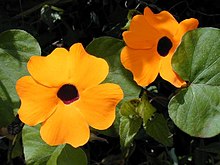
use
Medicinal plants
Some species are medicinal plants (selection):
- True hogweed ( Acanthus mollis )
- Kalmegh ( Andrographis paniculata )
- Baphicacanthus cusia
- Prickly water friend or prickly water frond ( Hydrophila spinosa )
- Justicia gendarussa (Syn .: Gendarussa vulgaris )
- Justicia procumbens
- Malabar nut ( Justicia adhatoda , Syn .: Justicia vasica )
- Peristrophe japonica
Ornamental plants
There are a number of genera in this family with a few species that are suitable as ornamental plants for parks and gardens, as well as indoor plants :
- Acanthus
- Aphelandra : e.g. glossy bulb ( Aphelandra squarrosa )
- Barleria : for example Barleria lupulina .
- Crossandra : for example Crossandra infundibuliformis
- Eranthemum : for example Eranthemum pulchellum .
- Fittonia ( Fittonia ): for example Fittonia albivenis
- Justicia : for example, house hops and Jacobin trees ( Justicia betonica , Justicia brandegeeana , Justicia carnea )
- Hemigraphis
- Hypoestes
- Odontonema
- Pachystachys : for example Pachystachys lutea
- Powder anthemum
- Ruellia : for example Ruellia elegans , Ruellia simplex
- Sanchezia : for example, Sanchezia parvibracteata
- Thunbergia for example Black-eyed Susanne ( Thunbergia alata ), Thunbergia erecta , Thunbergia laurifolia .
- Whitfieldia
Some species from the genus water lovers , also called water fronds ( Hygrophila ), are used as aquarium plants .
Animal feed
The South American species Trichanthera gigantea , which produces abundant protein-rich animal feed and is also used in Asia, can also be named as a useful plant .
swell
- The Acanthaceae family on the AP website . (Sections Description and Systematics)
- Yunfei Deng, Jia-qi Hu, Thomas F. Daniel, John Wood & John RI Wood: Acanthaceae . In: Flora of China Editorial Committee: Wu Zheng-yi, Peter H. Raven & Deyuan Hong (Eds.): Flora of China . Cucurbitaceae through Valerianaceae, with Annonaceae and Berberidaceae. Volume 19. Science Press and Missouri Botanical Garden Press, Beijing and St. Louis 2011, ISBN 978-1-935641-04-9 , pp. 369–378 (English, Acanthaceae - online - online text is identical to the printed work; printed work - full text online). (Sections Description, Distribution and Systematics)
- The family of the Acanthaceae , the family of Avicenniaceae , the family of Nelsoniaceae and the family of Thunbergiaceae at DELTA L. Watson and MJ Dallwitz. (Sections Description and Distribution)
- Lucinda A. McDade, Carrie Kiel, Erin Tripp: Acanthaceae, 2009: Entry in the Tree of Life project . (Sections Description and Systematics)
- Leslie Watson: Acanthaceae : Datasheet in the Western Australian Flora , 2008. (Description section)
- K. Vollesen: Acanthaceae (Part I). In: HJ Beentje, SA Ghazanfar (ed.): Flora of tropical East Africa , Royal Botanic Gardens Kew, 2008, pp. 1–286.
- Lucinda A. McDade, Thomas F. Daniel, Carrie A. Kiel: Toward a comprehensive understanding of phylogenetic relationships among lineages of Acanthaceae sl (Lamiales). In: American Journal of Botany , Volume 95, Issue 9, September 2008, pp. 1136-1152. doi: 10.3732 / ajb.0800096
Individual evidence
- ↑ a b c Erin Tripp, Ryan Stanfield: Acanthaceae Online Resource , August 17, 2011 ( Memento of the original from November 11, 2014 in the Internet Archive ) Info: The archive link was inserted automatically and has not yet been checked. Please check the original and archive link according to the instructions and then remove this notice.
- ↑ a b c d e f g h i j k l m n o p Yunfei Deng, Jia-qi Hu, Thomas F. Daniel, John Wood & John RI Wood: Acanthaceae . In: Flora of China Editorial Committee: Wu Zheng-yi, Peter H. Raven & Deyuan Hong (Eds.): Flora of China . Cucurbitaceae through Valerianaceae, with Annonaceae and Berberidaceae. Volume 19. Science Press and Missouri Botanical Garden Press, Beijing and St. Louis 2011, ISBN 978-1-935641-04-9 , pp. 369–378 (English, Acanthaceae - online - online text is identical to the printed work; printed work - full text online).
- ↑ a b The family of the Acanthaceae , the family of the Avicenniaceae , the family of the Nelsoniaceae and the family of the Thunbergiaceae at DELTA by L. Watson & MJ Dallwitz.
- ↑ a b c R. Hegnauer: Chemotaxonomy of Plants: Dicotyledoneae: Acanthaceae - Cyrillaceae , Volume 3, pp. 43-48.
- ↑ Antoine Laurent de Jussieu: Genera Plantarum , 1789, pp. 102-103 scanned in at biodiversitylibrary.org .
- ↑ Acanthaceae at Tropicos.org. Missouri Botanical Garden, St. Louis
- ↑ a b c Acanthaceae in the Germplasm Resources Information Network (GRIN), USDA , ARS , National Genetic Resources Program. National Germplasm Resources Laboratory, Beltsville, Maryland.
- ↑ a b Richard Olmstead et al .: Lamiales - Synoptical classification vers.2.4 (inprog.) Updated: July 26, 2012, A Synoptical Classification of the Lamiales Version 2.4 PDF.
- ↑ a b Lucinda A. McDade, TF Daniel & CA Kiel: Toward a comprehensive understanding of phylogenetic relationships among lineages of Acanthaceae sl (Lamiales). In: American Journal of Botany , Volume 95, Issue 9, 2008, pp. 1136–1152: full text PDF. ( Page no longer available , search in web archives ) Info: The link was automatically marked as defective. Please check the link according to the instructions and then remove this notice.
- ↑ Lucinda A. McDade, TF Daniel, CA Kiel, K. Vollesen: Phylogenetic Relationships among Acantheae (Acanthaceae): Major Lineages Present Contrasting Patterns of Molecular Evolution and Morphological Differentiation. In: Systematic Botany , Volume 30, Issue 4, 2005, pp. 834-862. Full text PDF.
- ↑ a b c d e f g h i j k l m n o p q r s t u v w x y z aa ab ac ad ae af ag ah ai aj ak al am an ao ap aq ar as at au av aw ax ay az ba bb bc bd be bf bg bh bi bj bk bl bm bn bo bp bq br bs bt bu bv bw bx by bz ca cb cc cd ce cf cg ch ci cj ck cl cm cn co cp cq cr cs ct cu cv cw cx cy cz da db dc dd de df dg dh David John Mabberley: Mabberley's Plant-Book. A portable dictionary of plants, their classification and uses. 3. Edition. Cambridge University Press, 2008, ISBN 978-0-521-82071-4 ( limited preview in Google Book Search).
- ^ Mats Thulin: Expansion of Crabbea (Acanthaceae) and the description of two new species from Somalia. In: Nordic Journal of Botany , Volume 24, 2006, page 502. doi : 10.1111 / j.1756-1051.2004.tb01629.x
- ↑ Dominique Champluvier, Iain Darbyshire: Schaueriopsis: a new genus of Acanthaceae (Acanthoideae: Barlerieae) from the Democratic Republic of Congo. In: Plant Ecology and Evolution , Volume 145, Issue 2, 2012, pp. 279-284. doi: 10.5091 / plecevo.2012.657
- ↑ Lucinda A. McDade, T. Daniel, SE Masta, KM Riley: Phylogenetic relationships among the tribe Justicieae (Acanthaceae): Evidence from molecular sequences, morphology, and cytology. In: Annals of the Missouri Botanical Garden , Volume 87, Issue 4, 2000, pp. 435-458.
- ↑ Species list for Salpinctium in the Red List of South African Plants
- ↑ Erin A. Tripp, Thomas F. Daniel, Siti Fatimah, Lucinda A. McDade: Phylogenetic Relationships within Ruellieae (Acanthaceae) and a Revised Classification. In: International Journal of Plant Sciences , Volume 174, Issue 1, 2013, pp. 97-137. JSTOR 10.1086 / 668248
- ↑ a b Acanthaceae at Tropicos.org. In: Flora Mesoamericana . Missouri Botanical Garden, St. Louis
- ↑ Erin A. Tripp, Siti Fatimah: Comparative anatomy, morphology, and molecular phylogenetics of the African genus Satanocrater (Acanthaceae). In: American Journal of Botany , Volume 99, Issue 6 2012, pp. 967-982. doi: 10.3732 / ajb.1100354
- ↑ Mariette Manktelow, Lucinda A. McDade, Bengt Oxelman, Carol A. Furness, Mandy-Jane Balkwil: The Enigmatic Tribe Whitfieldieae (Acanthaceae): Delimitation and Phylogenetic Relationships Based on Molecular and Morphological Data. In: Systematic Botany , Volume 26, Issue 1, 2001, pp. 104-119: online at JSTOR 2666658 .
- ↑ Lucinda A. McDade, Thomas F. Daniel, Carrie A. Kiel, Agneta Julia Borg: Phylogenetic placement, delimitation, and relationships among genera of the enigmatic Nelsonioideae (Lamiales: Acanthaceae). In: Taxon , Volume 61, Issue 3, 2012, pp. 637–651.
- ↑ a b c d e Entries on Acanthaceae at Plants For A Future
Web links
- Acanthaceae at Tropicos.org. In: Flora Mesoamericana . Missouri Botanical Garden, St. Louis
- Enter taxon in search mask in Flora do Brasil .
- Acanthaceae at the University of Hawaii Botany Department.
- Erin Tripp, Ryan Stanfield: Acanthaceae Online Resource , last update August 17, 2011.
- Search for "Acanthaceae" on the IUCN Red List of Threatened Species .
further reading
- Lucinda A. McDade, Carrie A. Kiel, Thomas F. Daniel, Erin A. Tripp: Biogeography of the Acanthaceae. In: South African Journal of Botany , Volume 74, 2008, p. 358.
- Guy Eric Onjalalaina, Iain Darbyshire: An endangered new species of Podorungia (Acanthaceae), with notes on the tribe Barlerieae in Madagascar. In: Kew Bulletin , Volume 71, Issue 3, 2016.
- Guy Eric Onjalalaina, E. Tripp, Iain Darbyshire: Ruellia domatiata (Acanthaceae), a striking new species from Madagascar. In: Kew Bulletin , Volume 72, Issue 1, March 2017. doi : 10.1007 / s12225-017-9676-7




